Language
- English
- Español
- Français
- Italiano
- Português
- Deutsch
- Nederlands
Currency
- AUD Australian Dollar
- CAD Canadian Dollar
- EUR Euro
- GBP Pound Sterling
- USD US Dollar
- ZAR Rand

When the word ‘Wildebeest Migration‘ is mentioned, most travellers picture hundreds of thousands of wildebeest and zebra brave crossing predators’ paths and charging into croc-infested rivers. This sums up what most of us know about The Migration, one of Africa’s most spectacular wildlife phenomena. And while you’d be perfectly correct in leaping to these mental images, their journey involves a whole lot more.
The heaving herds do fill the plains and rivers do provide locations for treacherous wildebeest crossings, but there's so much more to this awe-inspiring event than animals marching across the plains. Below, we've gathered some of our favourite Wildebeest Migration facts to keep in mind, so you know just what to expect before your upcoming Migration experience.
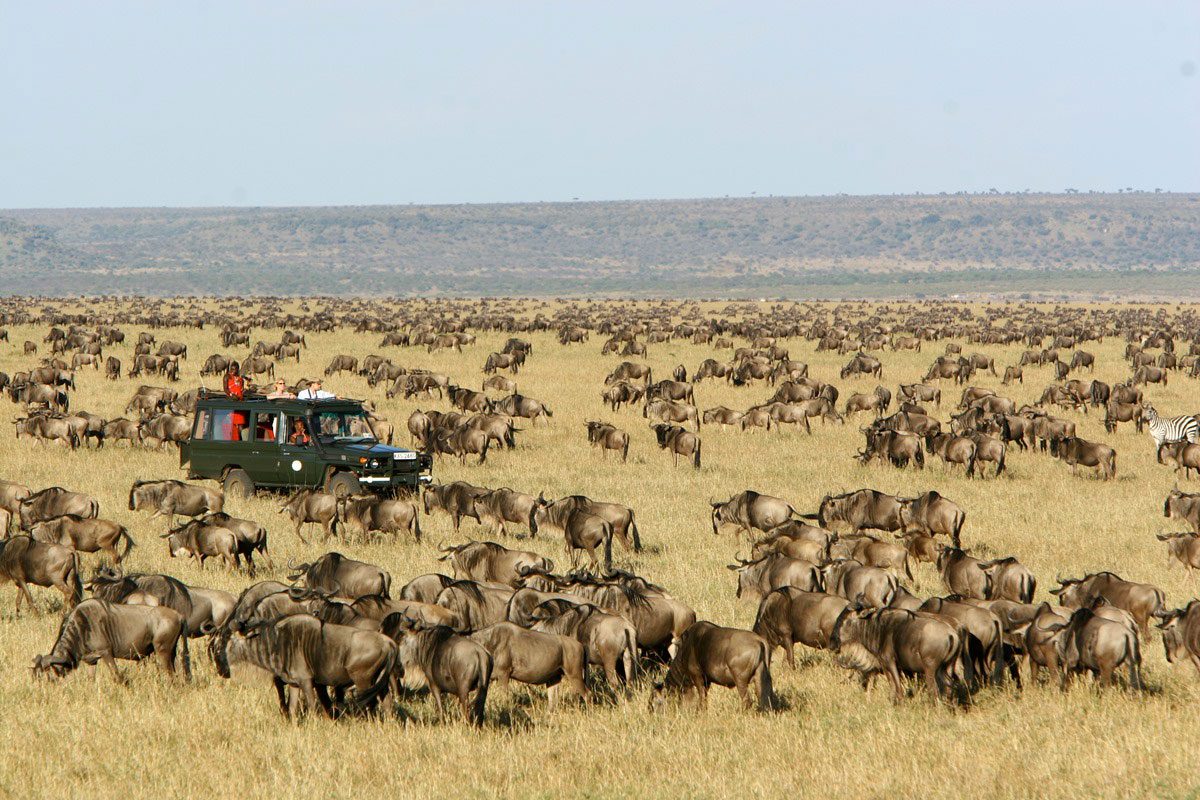
In East Africa, the ‘long rains' generally soak the ground in April and May, and the Serengeti plains spring to life with masses of sweet, delicious grass. This is the signal for wildebeest and zebra to start moving into the central Serengeti, mowing the abundant tender grass along the way.
Broadly speaking, this is exactly how it works. Except when the rains are late… Or when they're early… Or if it rains again unexpectedly and some (or even all) of the herds decide to turn back to feast on the fresh new grass. Unfortunately, these occurrences can interrupt the predicted journey and timing of the migration.
By June, the wildebeest and zebra should be in the Central Serengeti and getting ready for the toughest part of their odyssey: river crossings (about June to August). But not even the wildebeest know when they're going to cross. Some arrive at the rivers and swim over immediately, while others might spend days hanging around grazing. Some even arrive and turn back to where they came from!
Like so much in nature, it's safest to leave the idea of a firm schedule behind when it comes to the Wildebeest Migration. If you hope to see special events like a wildebeest crossing, it's best to plan as much time on safari as possible.
Go2Africa has been planning Wildebeest Migration safaris since 1998. We've helped thousands of travellers to be in the best possible place at the best possible time for the best possible price. If you're looking for expert planning advice, get in touch with one of our Africa Safari Experts.
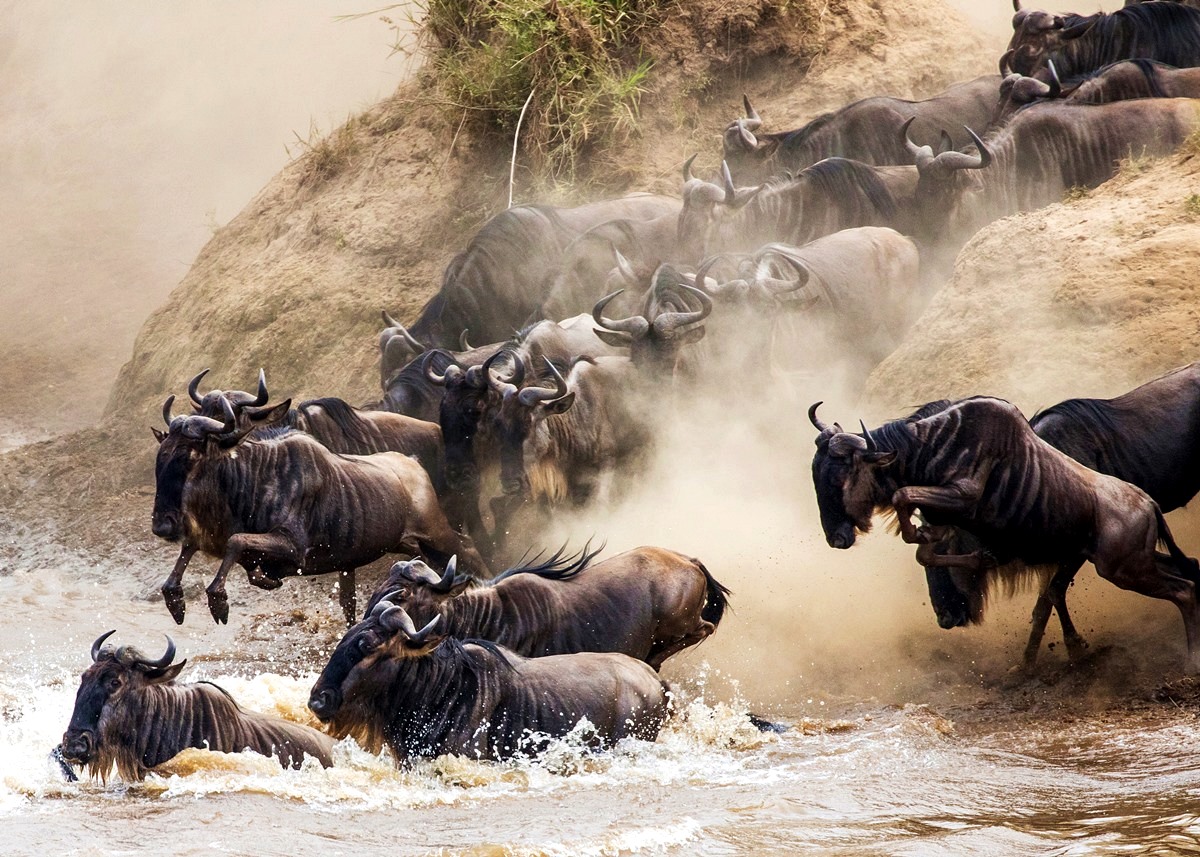
River crossings are considered the highlight of the spectacle: few other sights beat them for sheer drama and adrenalin value. Will crocodiles snatch the courageous gnu that leaps in first? Will the animals be able to scramble up the increasingly treacherous and slippery riverbank? Will weak or injured wildebeest be able to swim across at all?
Popular perception is that the wildebeest are galloping along at top speed and just crash into the water, following a sort of autopilot herd instinct. This isn't the case at all. Often, a herd will reach the river at a casual, leisurely pace … and then hang out on its banks for days, frustrating the crocs and tourists alike.Nobody knows how and why they suddenly decide to cross, but some sort of primeval signal is given.
The first intrepid pioneers will then scuttle down the often very steep sides and rocky riverbanks. You will naturally be rooting for these brave forerunners, but you'll likely witness heart-breaking moments too. An animal can often break a hind leg trying to climb a bank or lose its precarious grip and fall back down onto others, injuring them all. This is what makes a wildebeest crossing a true spectacle – the ecstasy and agony of survival, unedited, unfiltered, in raw true life.
If you aren't comfortable or prepared to witness animals getting injured or killed by predators, rather opt out of the river crossings. That being said, hundreds of thousands of wildebeest and zebra cross the rivers, so the odds of success are much greater. You're more than likely to witness a colossal herd successfully cross a river in a captivating, centipede-like motion.
If you do want to see a wildebeest crossing, on the other hand, it's vital to book your safari up to a year in advance to get a lodge on or as close to the river as possible. The animals do have historical crossing areas and you may spend days staked out in the hope of seeing the action – it's therefore also important to allow yourself as much time on safari as possible.
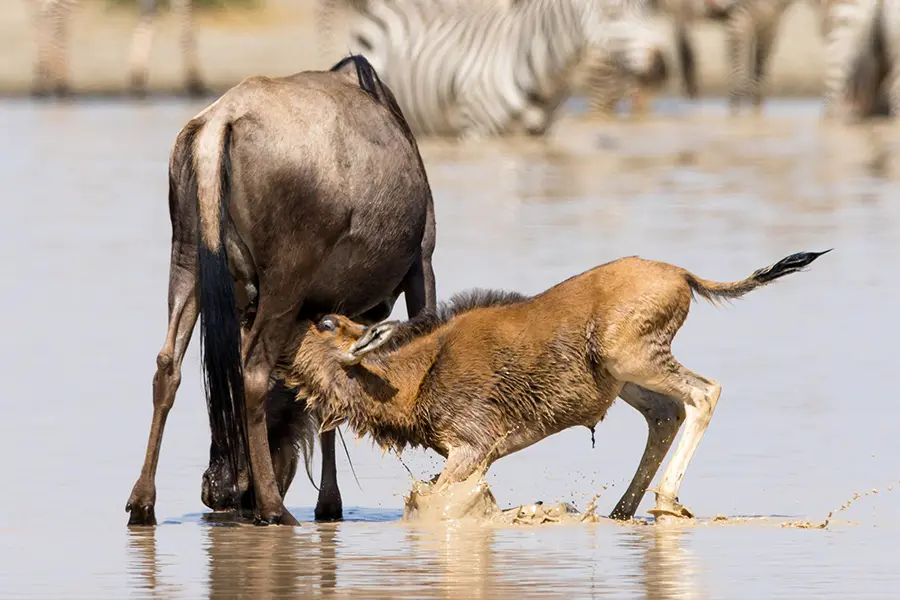
The calving season usually occurs from February to late March, when about 8,000 wobbly babies are born every day. Because the babies can run as fast as their moms within 48 hours, reaching speeds of up to 80 kilometers per hour (50 miles per hour), there are very touching scenes of tiny wildebeest speeding along and zebras nuzzling their foals.
But be warned: no aspect of the Gnu Migration is for the squeamish. Predators feast on newborns and you'll likely witness action-packed scenes of calves being run down by cheetah or snatched by lions. The pressure of predators is one of the reasons why nearly half a million wildebeest are born so close together. It's nature's numbers game. While many become the prey that sustains lion prides, enough survive to secure the future of the great herds. It may be a well-worn cliché, but the Wildebeest Migration is truly what ‘the circle of life' is all about.
If you aren't prepared to witness baby animals getting killed by predators, consider going on a Wildebeest Migration safari during another time of the year. It's an ever-moving journey with various other events that occur throughout the year.
If you are comfortable with real-life National Geographic scenes, this is a great time to go on safari. Wobbly young calves learn to run, and moms and babies across the plains spend time bonding. Of course, predator action is guaranteed during calving season and involves heart-stopping chases. But the predators don't always ‘win': zebras can deliver a kick powerful enough to crack a lioness's jaw, and wildebeest can outrun their hunters.
Where the predators do succeed, you can look forward to scavenger action: it's a great time to see vultures out in force as they perform their critical job of wilderness housekeeping.
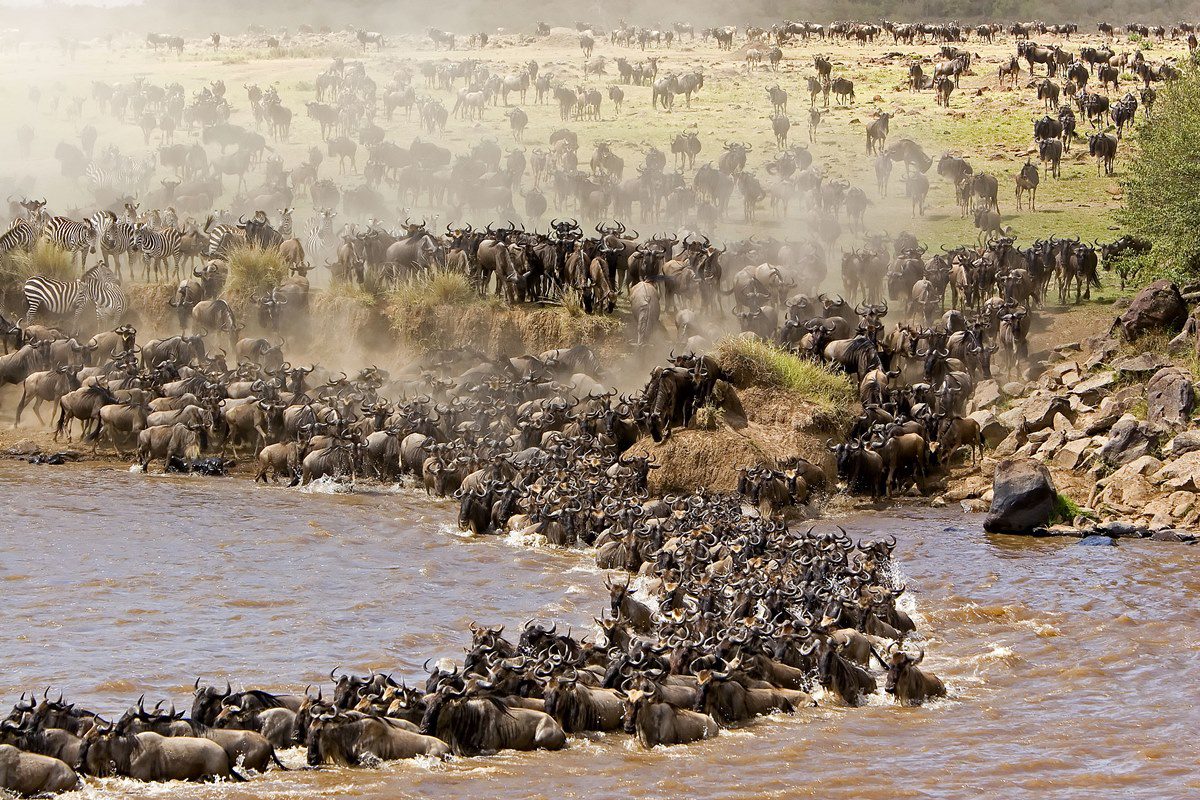
Yes, about two million wildebeest and zebra follow the rains on a 3,000-kilometre (1,900-mile) journey, but they don't travel all together all the time. Half of them would starve if they did!
They split into what are known as ‘mega-herds', which consist of thousands and thousands of individuals travelling on slightly different routes in more or less the same direction. After the rut (mating) season from about April to May, those that did not mate often break away from the others and form their own herds that travel through the central Serengeti. The animals form huge columns – sometimes up to 40 kilometres (25 miles) in length – that can be seen across the plains.
Members of mega-herds can be quite spread out, with the forerunners arriving at a new place sometimes a day or two ahead of the stragglers – kind of an ‘early warning system' for safari guides.
Being in the right place at the right time often depends on what exactly you want to see. Here's a guideline (with approximate dates) of events:
| Event | Approximate Time | Place | |||
|---|---|---|---|---|---|
| Calving (Birthing) Season | February to March | Southern Serengeti | |||
| Rutting (Breeding) Season | April to May | Western & Central Serengeti | |||
| Grumeti River Crossings | May to June | Central Serengeti | |||
| Mara River Crossings | July to August | Northern Serengeti & Masai Mara | |||
| On the Move | November to January | Masai Mara & Northern Serengeti to Southern Serengeti |
The Wildebeest Migration is a big draw card for Kenya's Masai Mara and Tanzania's Serengeti year on year. It is imperative to book early to get the best located camps for this spectacle as it is a highly anticipated event. If you can, I highly recommend for those visiting the Masai Mara to add on a Private Concession experience to ensure the trip is balanced. Private Concessions provide a crowd-free safari experience and allow you to fully immerse yourself in nature with fantastic game-viewing opportunities. A big bonus is the positive impact this makes to local communities and community run projects that are supported by the concessions.
Emma Hill, Africa Safari Expert
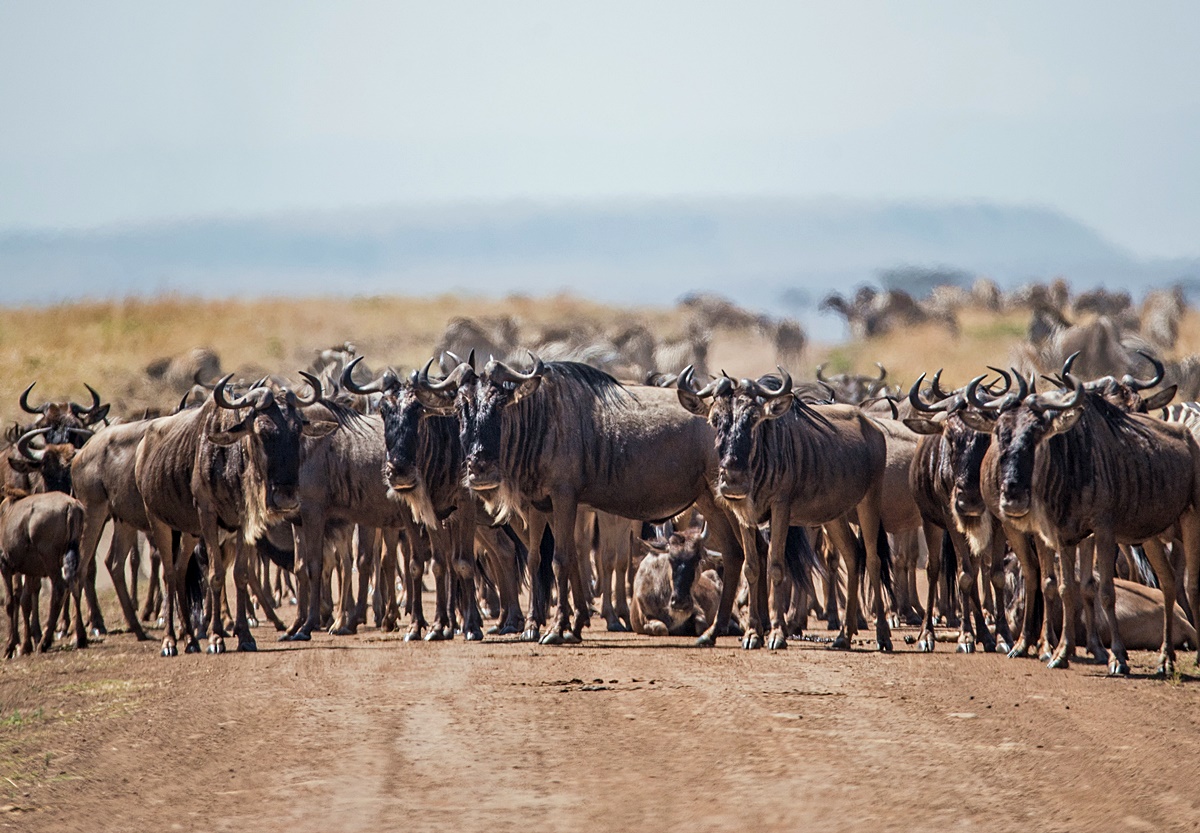
When do wildebeest Migrate? This is perhaps one of the most misunderstood facts about the Wildebeest Migration. Most people think that the Migration only takes place between July and October, but that's not the case. It's a fluid, year-round movement with various but equally exciting events.
The popular river crossings usually coincide with safari's high season (June to October), hence the perception that this is the only time of the year to see the Wildebeest Migration. Although the river crossings are absolutely riveting, they're only a small part of this epic journey. To understand this natural phenomenon, you have to ask, ‘Why do wildebeest migrate?'
Well, the Gnu Migration is dictated primarily by the wildebeest's response to the weather. It's triggered by East Africa's rains, and the animals follow their ancient instincts in search of fresh grazing and water. This epic journey takes the wildebeest across the Masai Mara, all the way south into the Serengeti and to the edge of the Ngorongoro Crater, before circling up and around in a clockwise direction. Here's a month-by-month breakdown:
If you want to go on safari between June and October, book early – at least a year in advance. Remember, this is safari's high season when the popular river crossings happen, so lodges and camps fill up fast.
Arrange your timing carefully. The Migration is a year-round journey and some of its events, like the river crossings, cannot be predicted. Find out all you need to know in our complete guide to the Wildebeest Migration.
Don't overlook the unsung joys of the low season. For starters, the animals spend November to March returning to their starting point in the southern Serengeti. This means you will still be treated to epic scenes of hundreds of thousands of wildebeest and zebra crossing the wide-open plains of the Masai Mara on their return to Tanzania. No matter when you see it, the sight of mega-herds on the move is always exhilarating.

Contrary to its nickname as the 'Wildebeest Migration', the migration is made up of much more than the gnus that have earned it its monicker. Unsurprisingly, wildebeest herds make up the greatest number of animals that take part in this journey with approximately 1.5 million of them present. However, there are also around 200,000 zebra, 300,000 Thompson's gazelle, and herds of eland and impala in smaller numbers.
The relationship between the wildebeest and zebra herds during the Great Migration is one that is mutually beneficial. While wildebeests prefer to graze on short grasses, zebras prefer longer grasses- this ensures that they do not compete directly for food. This complementary grazing behaviour is what helps maintain the balance of the ecosystem because it promotes the health and regeneration of the grasslands that they traverse.
In addition to the above, zebras possess keen eyesight and hearing, which, when combined with the wildebeests’ strong sense of smell, enhance the overall ability of the herds to detect nearby predators. This relationship perfectly sums up the intricate interdependence among the species that take part in the Great Migration; this quality is what makes it one of the most remarkable wildlife spectacles on Earth.
During the migration, pay attention to the harmony between all the herds. Watch how the wildebeests drive the migration, and the other species instinctively follow along, carefully listening out for signals. The Great Migration perfectly showcases the interdependence amongst all the species as each one has a key role to play in supporting the migration.

With each migration across the predator-filled plains of the Serengeti and the treacherous Grumeti and Mara Rivers, there are nearly 300,000 deaths. As mentioned above, the Great Migration catches the attention of many a land predator. Calving season invites large cats to try their luck at catching innocent and unsuspecting calves while larger predator groups will work together to separate lonesome wildebeests from the herds so they can attack with ease.
But land predators are not the only threat. River crossings are home to large crocodiles which lurk beneath the surface of the water, patiently waiting for the herds to wade in. The waters themselves cause drownings and are especially deep after the rainy season. Besides that, the wildebeests must overcome hunger, thirst, and exhaustion if they want to make it out in one piece. The Migration presents many challenges, and only the strongest make it out alive.
As harsh as it may sound, each aspect of the Great Migration -including the deaths- plays a crucial role in sustaining the wildlife and environments that these strong creatures come across and trek. Be prepared for the unexpected and appreciate the significance of each moment. If you would like to skip certain scenes or parts of the Migration, inform your Africa Safari Expert so they can do their best to provide you with the experience you want!

While humans may not be active participants in this perpetual trek (we'd hope not), our actions influence the Great Migration in several ways- both positively and negatively. Humans pose various threats to the migration through poaching and habitat encroachment. Climate change also affects different factors that influence the environment that the migratory species rely on and call home. The positive? We can do something about it.Through positive impact and various other initiatives, we can support the conservation of these species and their ecosystems. Conservation efforts play a crucial role in sustaining the migration, and sustainable tourism furthers this mission. By travelling sustainably and finding ways to contribute through positive impact, you can help preserve the Migration.
While you may be on holiday for leisurely purposes, you can still make a meaningful impact. Asilia is committed to positively impacting the environment and supporting the communities around their camps and lodges. Each night spent at an Asilia camp or lodge helps empower the local communities and sustain the landscapes and wildlife within the area.
Ubuntu Migration Camp and Olakira Migration Camp are both situated in prime locations for viewing the Great Migration, allowing you to indulge in absolute luxury while knowing that your stay is making a difference.

The same way most animals have unique sounds and calls that they use to communicate with one another, wildebeests use their grunts to help locate each other. During the migration, because the numbers are so high, these grunts become particularly helpful in allowing members of a herd, such as a mother and her calf, to find one another. The grunt is also useful in other scenarios, like when it's dark. You could say it helps wildebeests identify each other.
The low and resonant calls of wildebeests can also signal various states such as fear, distress, or alert other wildebeests to potential threats within the area. During the Migration, these grunts enhance the survival of the wildebeests by encouraging quick responses to the movements of the herds as well as warnings of nearby prowling predators.
Listen out for the deep and croak-like grunts of the wildebeests and see if you notice any reactions from the herds. Staying in one place for some time from the safety of your safari vehicle may even allow you to identify the warning signals of the wildebeests. If you're lucky, you could witness a kill if there are predators nearby that decide to make a move on any members of the pack!
Every true adventurer should witness at least one aspect of the Wildebeest Migration at least once in their lifetime. For sheer scale, there is no other animal phenomenon on the planet that beats it.
Although there's a traditional high season, the truth is that the Migration never stops. The ebb and flow of the mega-herds happen throughout the year. That means you can see the Migration year-round, so choose the season and destination that best suits you, and let us tailor-make your trip of a lifetime: